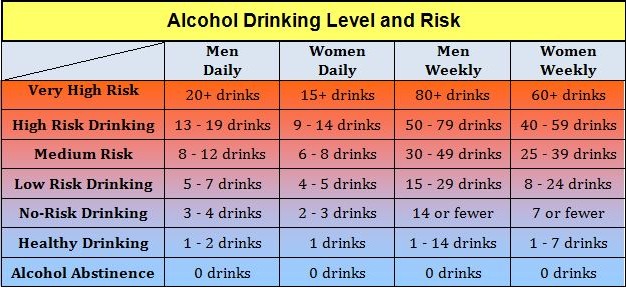The Risk Chart:

Using the Risk Chart:
You need to look at both your daily and your weekly risk levels to determine how risky your drinking habits are. If either your daily or your weekly drinking level falls into a high risk category then we suggest that you take steps to reduce the harmful impact which your drinking may have on you. We realize that some people like to engage in recreational intoxication so we recommend that these people take steps to practice safe drinking on their intoxication days. People who fall into the weekly high risk categories are at risk of organ damage and we urge them to take some steps to reduce overall alcohol consumption.
Sources for the Risk Chart:
HAMS bases our risk table "Alcohol Drinking Level and Risk" on the NIAAA definitions as well as published articles concerning alcohol and organ damage such as may be found on our web pages Myths and Facts about Alcoholic Brain Damage and Gender, Mortality, and Heavy Drinking.
The NIAAA defines moderate drinking as follows:
FOR MEN UNDER THE AGE OF 65: No more than 2 standard drinks per day and no more than 14 standard drinks per week
FOR WOMEN: No more than 1 standard drinks per day and no more than 7 and standard drinks per week.
FOR MEN OVER THE AGE OF 65: No more than 1 standard drinks per day and no more than 7 and standard drinks per week.
The NIAAA also defines a category of risk-free drinking as follows:
FOR MEN: No more than 4 standard drinks per day and no more than 14 standard drinks per week
FOR WOMEN: No more than 3 standard drinks per day and no more than 7 and standard drinks per week.
A fuller discussion of the definition of moderate drinking and risk-free drinking can be found on our web page What Is Moderate Drinking and What Is Risk-Free Drinking?
Drinking levels are lower for women than for men because the digestive tract of women contains less of the enzyme which breaks down alcohol than that of men does. This means that when men and women drink the same quantity of alcohol the blood alcohol content (BAC) of the woman will be higher than that of the man. In other words the same quantity of alcohol will make a woman more intoxicated than a man. Excessive quantities of alcohol may also tend to cause more organ damage to a woman than to a man. Men over the age of 65 have also been shown to process alcohol less efficiently than younger men.
Calculating and Charting Yout Drinks:
If you are charting your drinks because you wish to cut down on alcohol related risks then always be sure to measure standard drinks. Beware of bar drinks--many bars have heavy pours and a bar drink is often two or three or even four standard drinks.
If you want to calculate the number of drinks in a bottle of wine or liquor just use the HAMS drink calculator (in Excel). What follows are some examples of the number of drinks found in commonly sold bottles:
A half bottle of wine (375 ml at 12%, also called a split or a "demi") contains two and a half standard drinks.
A standard bottle of wine (750 ml at 12%) contains five standard drinks.
A 12 oz beer at regular strength (5% alcohol) is one standard drink.
A "half pint" of 80 proof booze (200 ml at 40%) is 4 standard drinks.
For more information about this topic please see our Psychology Today blog post U.S. Moderate Drinking Limits Are Completely Unrealistic.



